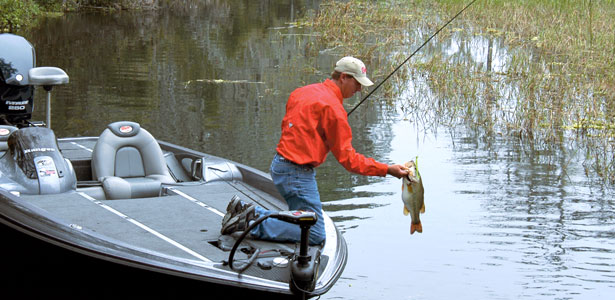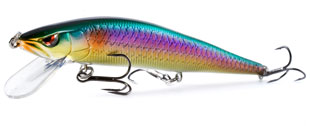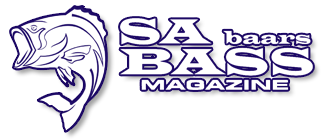
It happened at Albert Falls - a chilly spring morning greeted my dad and me at the dam. The imminent signs of the changing season set the tone for what we hoped was to be a memorable day. Our first stop was the "Ridge", a great early morning cranking spot, a spot made even better with knowledge of the fact that the pre-spawners should be on the prowl, looking for likely spawning areas. The Ridge is serviced by a massive "bowl" section of the dam and is the most vertical piece of structure to be found before the topography creates an immense flat which stretches forever. This is textbook pre-spawn territory and with this notion in mind our deep diving crankbaits took to the air.
I had the boat lined up to fire at what I thought was the key zone along the ridge and cranked the bait to the bottom - pause, retrieve, pause, retrieve, then on! First cast and I was bending on a solid fish. The fish was a definite 2kg plus - what a start! I fired back along the drop, cranked the bait half-way down and the game was on again. "They're schooled up!" I shouted and threw the marker buoy while giving instruction to my dad on where to cast. He cast in the same direction and was instantly on. The fish I was fighting was bigger and was staying down, so I took my time and let her come up slowly. I peered over the side of the boat to see what size fish I had on and was not quite prepared for what I saw. A solid 3kg fish had succumbed to my bait, but this was not what I was shocked over. The school of bass that surrounded the hooked fish was unbelievable, at least two hundred fish of similar size motivated by the distress of the hooked fish levitated in the clean water, with the odd giant attempting to rid the now tired bass of the crankbait protruding from its jaw. The next hour or so was obviously pandemonium, with every cast eliciting a savage strike from instinct possessed bass ranging from 2-4kg. We had definitely achieved what we hoped for, a memorable day!
Break lines adjacent to spawning flats
After analyzing a scenario like this, one understands the significance of the pre-spawn movement bass make. Literally hundreds of bass can use one migration route as their entry and exit route between their late winter hideouts and desired spawning areas. This is a killer pattern for targeting pre-spawners and probably my favourite pattern at this most crucial time of year. The Ridge at Albert Falls is a classic example of what to look for and these principles can be implemented on your local body of water. What you are looking for is the last major variation in the bottom contour or structure of a dam before the bottom adjoins with a major flat. This can be a drop-off, underwater point or feeder creek channel and becomes the last staging point for the ripe spawners. This will be their starting and ending point for their staging migrations until they conclude their spawn, making this gathering location the most inhabited area for the duration of the spawn. Not only this, with careful attention to detail and your electronics, these areas can be found with relative ease! Obviously locating cover in some form along the structure, or finding alternative structure intersecting with the topography is what you should be concentrating on to locate the mother load. I have a very particular line-up of baits when it comes to prospecting these pre-spawn areas. Search baits are the ticket, such as a deep diving crankbait which is a fantastic locator bait. Once I have located a fish or two, I will often slow down with a 3\8 oz slow-rolled spinnerbait or a 1\2 oz football jig to hone in on their position. A Carolina Rig is also a deadly way to put 'em in the boat during this time.
Spring 2008 saw Garth and I pre-fishing Goudetrouw ahead of a major competition. Our first day's practice had not really taught us much on this unfamiliar piece of water to us at that time. We decided to spend the next day dissecting a smaller piece of the dam, with the intention of deciphering at what stage the spawning process was in. We started on a shallow main lake point with a lipless crankbait and immediately picked off a few fish as we made our way into the adjacent bay, serviced by a creek channel which undoubtedly joined up with the offshore main lake channel. This bay had all the makings of text book spawning bay. There were two other shallow secondary points within the bay that we were instinctively drawn to. They both had fish, big fish with one going just under 5 kg. Now we were moving in the right direction but I felt something was still missing. I looked across the bay to a vertical cliff face on the channel bank of the bay and idled over. I figured this was the route the spawning fish would be using, stopping on the secondary points and finishing their cycle on the flats and banks within the bay. The jig was my weapon of choice and rightly so as it was not long before a giant female was having her way with it. When the 4kg plus fish surfaced there were another two fish of similar size cruising with her confirming the fact that this vertical rock-face was indeed a staging point for schools of pre-spawn females. The attraction this bay had in regard to the spawning process was exposed 2 weeks later when we won the tournament here. There were still some pre-spawners to be found but most of the fish were now post spawn and were now using the exact same area as a resting zone before following the creek channel back out to the main lake to assume their summer routines.
Primary and secondary points combined with vertical structure.
Main lake fish often gravitate to the nearest main lake point to begin the spawning process, making their way to the secondary points and ultimately the flats in the bays. A bay with some form of vertical structure is always a winner as this results in the fish only needing to make a vertical adjustment when needing to feed. This means less water for them to cover to achieve an optimum situation, whether it is a desired water temperature or as mentioned, intent to feed. Not all main lake points are created equal, points that extend furtherest into the lake will service more area, in turn attracting more fish. Points with a main lake channel sweeping past are even more important as these channels are the highways bass will use to migrate into the spawning areas after stopping on the points to stage or feed. Points with flat adjacent to them are also key points as some fish, if the desired factors are located will spawn just off the main and secondary points, so don't ignore this either. On these points and vertical structure, a suspending jerkbait is almost illegal! I rapidly fish one with long pauses parallel to the rock structures to appeal to schools of suspending fish waiting to make their move. The jig tactic as mentioned is a must as well, especially off the deeper edge of the primary points.
Points with a main lake channel sweeping past are even more important as these channels are the highways bass will use to migrate into the spawning areas after stopping on the points to stage or feed. Points with flat adjacent to them are also key points as some fish, if the desired factors are located will spawn just off the main and secondary points, so don't ignore this either. On these points and vertical structure, a suspending jerkbait is almost illegal! I rapidly fish one with long pauses parallel to the rock structures to appeal to schools of suspending fish waiting to make their move. The jig tactic as mentioned is a must as well, especially off the deeper edge of the primary points.
These are just 2 scenarios with one thing in common, pre-spawners schooled up on key areas. Your job is to find these key areas, use the right baits, and understand why the fish are there and where they are going. The rest is easy!


 Visit us our
Visit us our